The Rising Tide: How One IT Team Redefined Emergency Communications
February 16, 2016
7 minute read
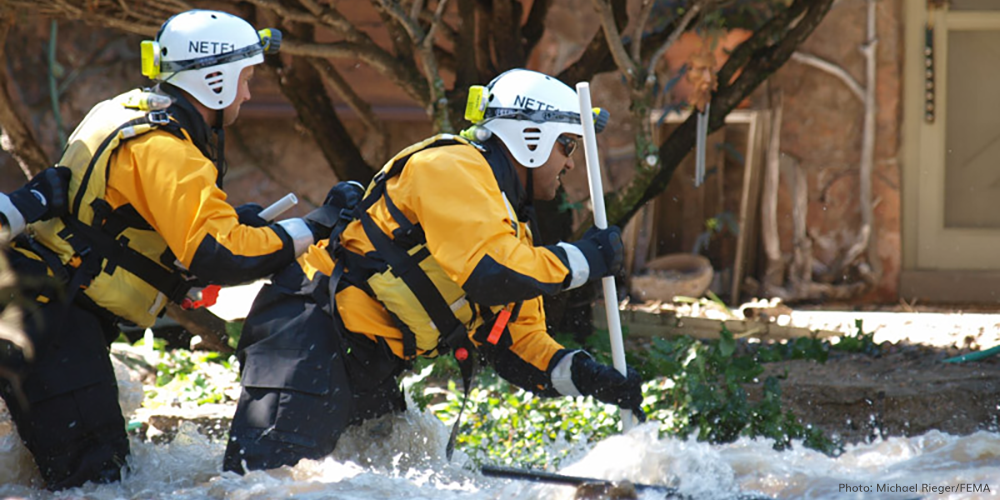
In a field near Jamestown, Colorado, a woman huddles over a car seat holding her child. Behind the woman, a rescuer walks to escort her and her child to a grounded CH-47 Chinook helicopter, whose dual rotors spin loudly less than a football field away. Two hours away, just west of Colorado Springs, onlookers watch helplessly as a mudslide on Highway 24 destroys their cars.
These aren’t movie scenes; they’re surreal snapshots of one of the most devastating natural disasters in Colorado state history. For eight straight days in September 2013, unprecedented flooding decimated Boulder, Fort Collins, and other cities along the Front Range, Colorado’s most populous region. For perspective, the average annual rainfall for Boulder is 20.6 inches. On Sept. 12 alone, the city was drenched with 9.08 inches, well on its way to experiencing the wettest year on record.
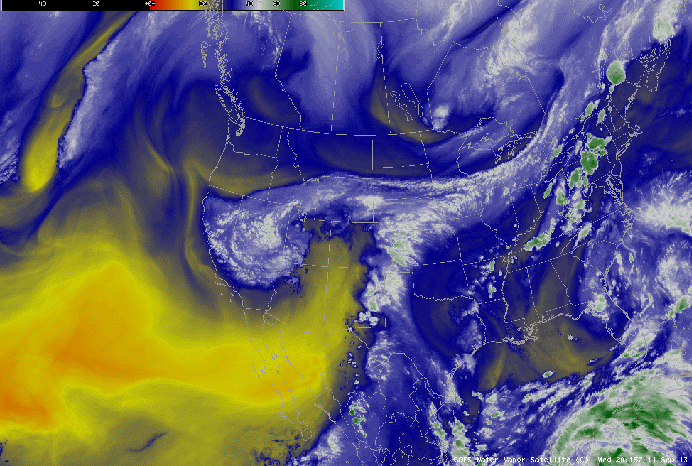
The 2013 storm system swirls over the Colorado Front Range. Cooperative Institute for Meteorological Satellite Studies (CIMSS), University of Wisconsin – Madison, USA
When you think of who makes a difference during natural disasters, you might think of rescue workers, police officers, firefighters, and volunteers–and of course, you’d be right. But with our reliance on technology for communication and information gathering when disaster strikes, there’s a story that falls into the footnotes. What does a state’s IT department do during a natural disaster?
Building a Crisis Map
“It’s sad, but true: Emergencies have a way of smashing through political red tape,” says Brandon Williams, the State of Colorado’s director of Google operations for the Governor’s Office of Information Technology. Williams, who has worked in IT for three years, led the state’s 2012 initiative to roll out Google Apps to its 26,000 employees. Colorado was the third state behind Wyoming and Utah to go switch to Google Apps.
When the flooding began, Colorado’s 25 state agencies operated in quasi-silos. Incident information like road closures, shelter locations, and weather conditions was spread out across state, local, and federal levels. It was chaotic, and for Colorado citizens facing rising flood waters, emergency information was difficult to find.
State government needed to produce a crisis map that brought every available piece of incident information together. The crisis map needed to be shareable, embeddable, and accurate; it needed to be the “single source of truth,” says Williams.
“In government, ownership of information is always key,” says Williams.
Through an executive order, each State of Colorado department was required to provide all relevant incident information to the Governor’s Office of Information Technology. Williams, with help from the Google Crisis Response team, then consolidated every piece of incident information into a single Google Crisis Map.
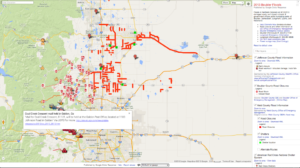
The consolidated Google Crisis Map revealed hazardous areas along with markers designating American Red Cross centers and other emergency-related information.
“A lot of problems during disasters are typically information problems,” said Nigel Snoad, product manager at Google Crisis Response. “People are increasingly turning to the Internet during this time.”
Without official sources, those in need and the media can only cobble together bits and pieces of incident information (some accurate, some not), making it hard to distinguish fact from fiction.
“It [the Google crisis map] was definitely a source of great relief in a time of uncertainty,” said Colorado resident Nick St. George in an interview days after the flooding began. St. George relied on the crisis map to direct his girlfriend as she drove from South Dakota to her home in Longmont, Colorado.
“I think that’s probably one of the longer lasting legacies,” says Williams when referring to the Google Crisis map. “The coordination was amazing. We now have a place where we can pull together information and churn out maps very quickly. We didn’t have that before.”
By creating a single source of truth (the Google Crisis map), the government stunted the spread of misinformation and ensured that the media and the citizens of Colorado were sharing the most up-to-date and accurate information available.
Searching for Help
“Wave a sheet, put a sheet on the roof, fire off flares, even use a small fire so we can see the smoke,” Ben Pennymon, spokesman for the Boulder County Office of Emergency Management told stranded citizens. Use a mirror to reflect sunlight, he said.
In eight days, 18,000 homes and businesses were either damaged or destroyed, and more than 10,000 individuals were forced to evacuate their homes. Lt. Mitch Utterback of the Colorado National Guard called it the largest aerial rescue effort since Hurricane Katrina.
What started as a typical September shower was soon being called a 1,000-year rain and 100-year flood. People were left searching for answers–where to find food, water, shelter.
Williams and his team worked directly with the Google Crisis Response team to prioritize search results. Anyone searching for key terms like water, food, flood, emergency, shelter, and more received direct results from Google to official government emergency information. “This wasn’t just built on the fly — it was a direct partnership with Google to make sure that official information was included in search results,” says Williams.
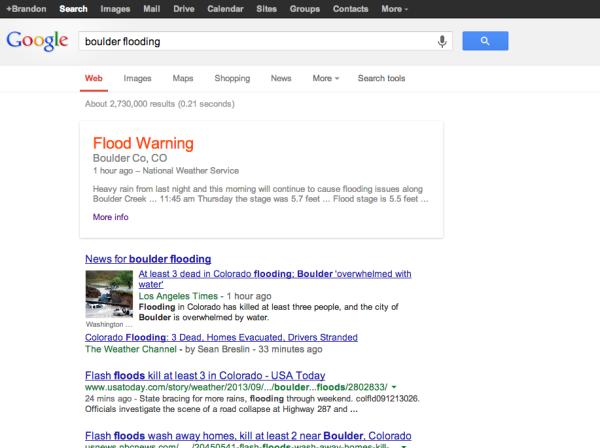
Creating ColoradoUnited.com
As the rains let up, the $4 billion road to recovery began.
“Instead of fractured emergency management, the Governor wanted one hub for all of Colorado’s recovery-related information,” says Williams.
With time against them, Williams worked with Colorado incubator Galvanize and Simply Local, a design firm, to create the official State of Colorado website for resiliency and recovery information and resources. The site, appropriately named Colorado United, is still operational today.
Remarkably, Colorado United was built in just 48 hours (for free) using Google Sites. “We knocked out a full Google site, got it coordinated with nine different response agencies, and established a mobile-friendly site that housed all the information,” says Williams. “It’s not the flashiest, but it does the trick. It modifies for mobile. It’s easy for people to update who are not super technical.”
The site remains the central point of assistance and recovery information for those who have been affected by any emergency or natural disaster, from small business owners to displaced families.
“We can do this better.”
When speaking with Brandon Williams, it’s hard not to notice the way the floods affected him. His retelling is poignant at times–as if it happened weeks before. In reality, three years have passed.
“Before coming to the state, I was with the fire department up in the mountains. I’d always been on the lights and sirens end of an incident,” says Williams. Up until the days following the floods, Williams had never been to a Disaster Assistance Center (DAC). “When I got there I was surprised at what I found.” Hundreds of people stretched out in long lines, waiting to fill out 20 different types of paperwork to receive assistance from the government agencies and nonprofits on hand.
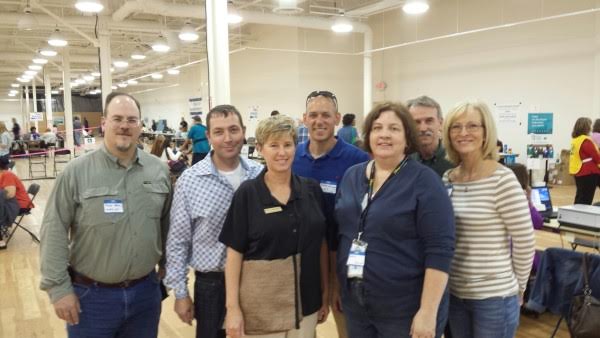
Brandon Williams (center) stands with his team and volunteers at the Boulder Disaster Assistance Center.
People were scared; many had recently been airlifted by helicopter out of their homes. “By the time they got up to the front of the line, there was a cardboard table that had a stack of forms and a box of Kleenex. It was cruel,” says Williams. “We can do this better.”
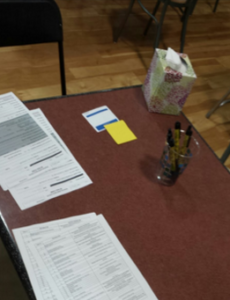
A photo Brandon Williams took of the paper processes at the Disaster Assistance Center in Boulder.
Creating Change With Help From the Community
With the technology in place, Williams and his team needed to reduce the amount of paperwork required to receive assistance. But how?
After some thought, they built a rudimentary system that linked Google Forms and Sheets together. It worked, but it was it was a duct tape solution.
Williams and his team wanted to go further.
When the flooding stopped, the State of Colorado met with the Google team to discuss issues they had when setting up their Forms and Sheets solution. “Google said, ‘We’ve kicked around the idea of doing a government hackathon for a while. What do you think?’”
Together with Google and the State of Wyoming, the State of Colorado agreed to host 140 teams at the state’s first-ever government hackathon: The Google GovDev Challenge.
The hackathon was an opportunity to rethink technology in government. “The biggest problem with technologists is that you end up with experts,” says Casey Carlson, Chief Enterprise Architect at the State of Colorado. “They become very beholden to their technology. People don’t stop to ask: Is there a better, smarter way?”
Rethinking Processes and Problem Solving
Thanks to the GovDev Challenge, Williams and other government officials were able to take a step back and rethink processes, he says. “Here’s how we do it today. How could we make this better? What other tools are we overlooking? Other things like maps? Other things like scanning? How can we make this whole process better?’”
One winning team created a website that allows disaster victims and volunteers to fill out a form online, saving time by eliminating the tedious task of entering the same information for many paper forms, according to Google for Work’s official blog. “It’s had a really long-lasting effect in a number of areas,” says Williams. “When you boil down those two basic processes, which are forms and tracking things, they have such a wide applicability in all aspects of government.” The ideas generated during the GovDev Challenge have been put to use in unanticipated ways, from tracking driver’s license information to project management.
“That was one of the biggest places that we thought we could create transformation with the Google platform,” says Carlson when discussing paper and manual processes. “A lot of folks had to step outside their comfort zone and start to make some transformations–it’s carried over into a lot of other processes, past and present.”
Capitalizing on Moments of Disruption
When asked what his biggest learning moment was during the 2013 Colorado floods, Williams had this to say: “It’s important to realize how much you don’t know, and the point is you know less and less every day. The more that you realize what your limitations are and what the opportunities are, the more you’re willing to reach out to the private sector and nonprofits. That’s how you truly make something revolutionary–by using the brainpower of a lot of different and non-traditional sources.”
With the right tools in place, you can act quickly and create change, says Carlson. He emphasized the essential need to capitalize on moments of disruption. In government, these moments are few and far between. “We take a very platform-centric viewpoint on all of our technology. We believe that you need to invest in a platform that can rise to the occasion in times like these.”
Next time you hear IT referred to as simply a helpdesk where passwords are reset and broken computers are mended, think of Colorado. Think of the IT department that provided clarity in a time of immense uncertainty.






